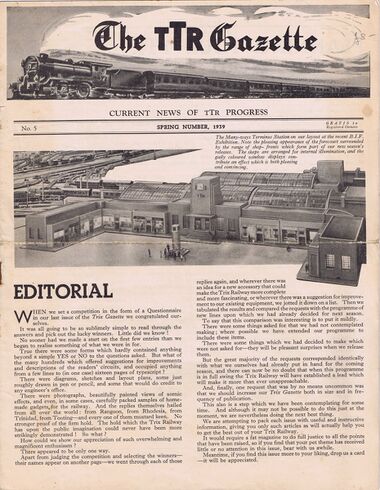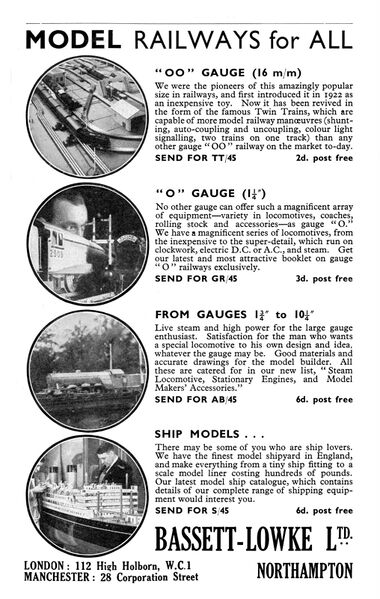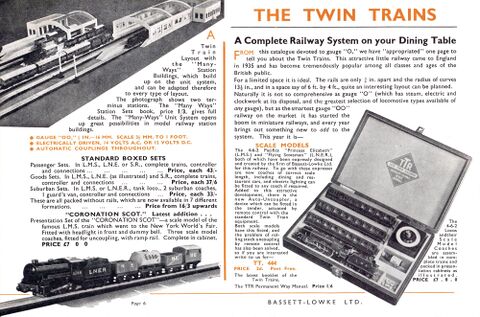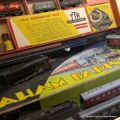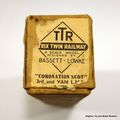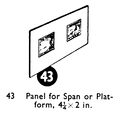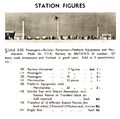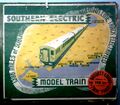Category:Trix Twin Railway
| Toy Brands and Manufacturers |
|---|
Trix Twin Railway |
| 1935 - |
Trix Twin Railways, basic system specifications [image info]
1937: update advert, mentioning the "Many-Ways" stations and the green "Southern Electric" train sets [image info]
1939: TTR Gazette, Spring 1939 front cover, with photo of a "Many-Ways" station [image info]
1939: "Model Railways for All" Bassett-Lowke advert, late 1939. This variant on their usual three-circles" now finally includes a fourth circle for Trix 00-gauge trains, now presented as a major B-L product range [image info]
Box end label for a TTR Coronation Scot carriage, "A SCALE MODEL DESIGNED BY BASSETT-LOWKE" [image info]
In the early 1930s, Stefan Bing had left the Bing company before it folded, and acquired a new metal toymaking business that had then started producing Trix construction sets. The new company was then persuaded by W.J. Bassett-Lowke to "have another go" at producing an 00-gauge model railway system, a previous agreement between B-L and the Bing company having been responsible for the trail-blazing (but short-lived) Bing Table Railway system in the 1920s. The new system, which cleverly exploited a three-rail track to allow independent control of two locomotives on the same track, appeared in the UK as the Trix Twin Railway (TTR). After setting up Trix Limited in the UK, Stefan felt the need to relocate out of increasingly Nazi-dominated Germany, and moved to the UK. The TTR mechanisms were initially manufactured in Germany with the British-outline bodyshells produced in the UK, but as relationships between England (and Stefan) and Germany became more strained, the need to manufacture in the UK led to progressively more manufacturing beign carried out in the UK, at Winteringham Ltd. (an affiliate of Bassett-Lowke) and other sites.
The product lines of Trix Limited and the original German Trix company then diverged, with the German HO-scale trains continuing to be sold under the name Trix Express.
The TTR system
Trix Twin Railway (TTR) allowed independent control of two separate locomotives on a single common layout using three-rail track and two separate controllers. The two outer rails were used as separate independent power lines, and the centre rail was "common".
Trix vs Bassett-Lowke
The TTR range seems to have been a cause of friendly tension between Stefan and W.J. Bassett-Lowke, with both men trying to put their own mark on the range. Trix included ideas from both companies' personnel, and for a while there appeared to be some internal competition about naming. A catalogue from 1937 shows the TTR logo and name on almost every page inside the catalogue, but the catalogue's cover instead announces "The Bassett-Lowke Twin Train Table Railway".
This marked an odd period for TTR, with Stefan Bing being firm that this was his Trix system, and W.J. advertising the sets as "Designed by Bassett-Lowke", apparently removing the Trix name wherever possible, and helpfully explaining that "TTR" stood for "Twin Train Table Railway" (TTTR!). With Stefan distributing production around a number of factories to avoid concentrating too much power in the Northampton factory that was subject to influence by B-L, some trains even show signs of having been painted with the Trix name, and then overpainted with the B-L version of the TTR name.
Bassett-Lowke promoted the TTR range quite heavily in advertising and in their catalogues (as "theirs"), and in late 1939, their three-circle adverts promoting their three main "consumer" businesses - model ships, gauge 0 trains and larger-gauge railways - gained a fourth circle for the 00-gauge Trix range.
1938 advertising text:
TTR – The Greatest little Train in the World
Imagine a model railway, working from electric mains or batteries, which besides looking like the real thing, works like the real thing! Two trains running simultaneously at different speeds, forward or backward, fast, slow or very slow, on the same track if you like – that's the Trix Twin Railway. Each locomotive is separately controlled and can be made to shunt as in real railway work, just by pressing a button. The locos even couple up to their own rolling stock, thanks to an ingenious automatic coupling device.
All the Trix accessories are constructed with the same eye for exactness of detail as the trains themselves. The permanent way is built up in sections on bakelite bases and can be fixed or unfixed in a moment. A complete range of Trix "Manyways" Station Sets enables you to construct anything from a suburban station to a main line junction.
— , Trix Ltd., , Hobbies Handbook, , 1938
1939 Bassett-Lowke Ltd advertising text:
(Referencing the earlier 1920s Bing Table Railway system).
"00" gauge (16 m/m)
We were the pioneers of this amazingly popular size in railways, and first introduced it in 1922 as an inexpensive toy. Now it has been revived in the form of the famous Twin Trains, which are capable of more model railway manoeuvres (shunting, auto-coupling and uncoupling, colour light signalling, two trains on one track) than any other gauge "00" railway on the market.
Post-war
When the war shortages receded it became clear that in the new environment, 00-gauge was the future of model railways in the UK, with TTR pitted head-to-head with Hornby Dublo, which had launched in 1938. Although the Trix range was technically innovative, the finish and external engineering on the Dublo range was nicer - Dublo wheels looked less clunky than their Trix brethren, and Meccano Ltd was able to pour more resources into Dublo than B-L were with Trix. Dublo also embraced two-rail running (after a painful migration from three-rail), which was something that Trix couldn't do without losing their unique selling point of having two trains on a single track.
TTR and Dublo were both then undercut by the new cheaper plastic trains and rolling stock from Triang, and when Lines Bros took over the Hornby brandname and used it to sell plastic-bodied trains (whose quality and detailing continued to improve), Trix found themselves in the unenviable position of having a system that seemed less detailed (and was less well-resourced) than Hornby, who had the double advantage of the stronger "expensive" brandname and marketing, coupled with the cheaper-to-produce Triang-based product.
British Trix Ltd. (1964)
The new catalogue that appeared with a January 1964 flyleaf date now described the company as "British Trix Ltd., with a "Courtalds Group" logo. The company history in the 1964 catalogue emphasises the company's past migration towards plastics and two-rail-compatible locos, the move towards DC (direct current) systems rather than AC that had started in 1956, and the standardisation of track (heights, points spacings and segment lengths) to make the system interoperable with other companies' products and accessories.
The move to wards maximum compatibility wasn't just for the customers' benefit, as the '64 catalogue says:
- " The New TRIX range has been enlarged considerably with equipment from some well-known manufacturers on the Continent, including Trix Express, Liliput and Tempo. Items from these ranges are completed in this country, fitted with British scale wheels and Trix couplings. "
At this point, the new "rationalised" Trix company was probably easier to manage, selling a wider range of trains and accessories without having to create the tooling themselves ... but was also arguably no longer a pure "source" company, as many of the pieces in their range were no longer designed in-house, but imported and adapted. Ironically, having previously broken away from Bassett-Lowke to retain their independence, they'd now adopted Bassett-Lowke's business model.
Trix Trains (~1967/68-)
This period saw Trix being taken over by the German Trix company and production moved to Wrexham, under Thernglade Ltd. This continued until 1973, when the Trix brand became part of Rovex.
External links
Subcategories
This category has the following 2 subcategories, out of 2 total.
T
- Trix Manyways station sets (20 F)
- TTR Presentation Sets (3 P, 3 F)
Pages in category ‘Trix Twin Railway’
The following 13 pages are in this category, out of 13 total.
C
L
P
Media in category ‘Trix Twin Railway’
The following 49 files are in this category, out of 49 total.
- Area 43.jpg 1,024 × 1,024; 619 KB
- Ashfield Station and Southern train set, Bassett-Lowke (MM 1941-09).jpg 1,600 × 618; 198 KB
- Bassett-Lowke advert (SRMT 1939).jpg 1,015 × 1,600; 317 KB
- Bassett-Lowke Twin Train Table Railway 1938 catalogue.jpg 1,326 × 2,000; 803 KB
- Bassett-Lowke Twin Trains (BLcat 1939).jpg 2,000 × 1,321; 573 KB
- Bassett-Lowke, TTR (BL-MR 1937-11).jpg 882 × 1,200; 188 KB
- Box end label for Coronation Scot carriage (Trix Twin Railway).jpg 800 × 799; 381 KB
- Hamleys 1939 catalogue, page11, Trix Twin Railway TTR (HamleyCat 1939).jpg 936 × 1,200; 350 KB
- LMS 4-4-0 locomotive 4-536 (TTRcat 1939).jpg 1,600 × 630; 205 KB
- LNER 4-4-0 locomotive 4-536 (TTRcat 1939).jpg 1,600 × 566; 191 KB
- Manyways 02, Narrow Ramp (TTRcat 1939).jpg 883 × 524; 48 KB
- Manyways 04, Wide Ramp (TTRcat 1939).jpg 947 × 574; 64 KB
- Manyways 12-15, Narrow Platform (TTRcat 1939).jpg 1,483 × 709; 101 KB
- Manyways 14-15, Wide Platform (TTRcat 1939).jpg 1,495 × 674; 133 KB
- Manyways 22, Awning Platform (TTRcat 1939).jpg 1,341 × 925; 140 KB
- Manyways 32, Goods Shed (TTRcat 1939).jpg 1,010 × 829; 111 KB
- Manyways 35, Quadrant Piece (TTRcat 1939).jpg 920 × 947; 69 KB
- Manyways 37, Annexe Building (TTRcat 1939).jpg 1,320 × 989; 161 KB
- Manyways 38, Main Building (TTRcat 1939).jpg 1,533 × 1,131; 219 KB
- Manyways 39, Tower Building (TTRcat 1939).jpg 989 × 1,373; 102 KB
- Manyways 42, Span with Celastoid Roof (TTRcat 1939).jpg 1,463 × 1,105; 207 KB
- Manyways 43, Panel for Span or Platform (TTRcat 1939).jpg 932 × 882; 67 KB
- Manyways 44, Single Buffer End (TTRcat 1939).jpg 880 × 564; 39 KB
- Manyways 48, Double Buffer End (TTRcat 1939).jpg 935 × 605; 56 KB
- Manyways 91, Small Steps (TTRcat 1939).jpg 883 × 484; 31 KB
- Manyways 92, Entrance Steps (TTRcat 1939).jpg 901 × 562; 67 KB
- Manyways Shopfronts (TTRGaz5 1939).jpg 2,400 × 1,072; 531 KB
- Manyways station buildings (TTRcat 1939).jpg 976 × 1,600; 325 KB
- Pullman TRIX TWIN carriage (TTRcat 1939-).jpg 1,600 × 867; 158 KB
- Southern electric three-coach train (TTRcat 1939).jpg 1,600 × 1,200; 309 KB
- Southern Electric train set (BL-TTRcat 1938).jpg 1,332 × 2,000; 701 KB
- Station Figures, Britains for Trix TTR (BL-TTRcat 1938).jpg 3,107 × 3,080; 783 KB
- Trix Crane Truck Set (TTRcat ~1963).jpg 2,069 × 1,221; 373 KB
- Trix Manyways 1939.jpg 2,517 × 1,525; 612 KB
- Trix Princess.jpg 2,048 × 1,391; 324 KB
- Trix Twin Railway catalogue, 1939-1940.jpg 1,200 × 978; 201 KB
- Trix Twin Railway text.jpg 1,024 × 519; 121 KB
- Trix Twin Railways catalogue cover ~1963.jpg 2,200 × 1,713; 726 KB
- Trix Twin Railways presentation sets.jpg 3,000 × 906; 604 KB
- TrixTwin CoronationScot.jpg 517 × 493; 39 KB
- TTR catalogue 1939-40 cover.jpg 1,722 × 2,820; 816 KB
- TTR catalogue green Southern electric 1939.jpg 1,025 × 1,285; 235 KB
- TTR Coronation Scot 1939 red US tour set.jpg 1,717 × 2,832; 643 KB
- TTR Gazette Spring 1939.jpg 1,240 × 1,600; 629 KB
- TTR green Southern electric train set (1939).jpg 1,152 × 1,011; 173 KB
- TTR logo summit.jpg 519 × 349; 28 KB
- TTR logo TwoLocos.jpg 469 × 455; 37 KB
- TTR Passengers, Station Staff and Equipment (Trix Twin Railway).jpg 1,024 × 765; 431 KB




